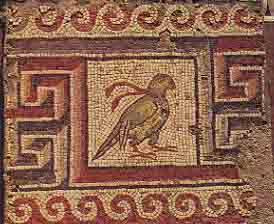Image Details

Zev Radovan
Designed to impress and attract the general public with their splendor, churches in the time of the Roman emperor Constantine (the fourth century) were highly ornate, a major departure from the modest house-churches used by earlier Christians. In addition to fancy columns and capitals, wall paintings and gilded chandeliers, the pavements usually consisted of mosaics, as in this example from the Byzantine church at Horvat Berachot, about ten miles southwest of Jerusalem. This superbly executed nave mosaic of a beribboned bird—possibly a hunting falcon, which was often adorned with a ribbon around its neck—employs especially small tesserae (nearly 1,500 per square foot). One of a series in the pavement, the bird is framed by a square, about one foot on a side, which is in turn surrounded by a wave-crest pattern on two sides (only one shown) and, on the other two sides, a meander pattern skillfully shaded to create a three-dimensional illusion.
